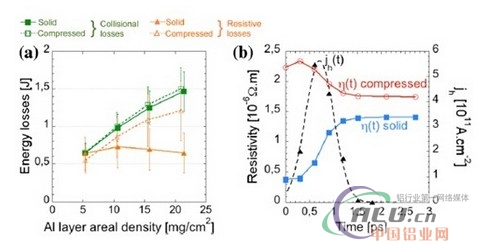ã€ALUMINIUM NETWORK】Infrared confinement fusion electron-driven fast-ignition electron source is generated by interaction between a super laser and a dense target, with an intensity of approximately 1020 to 1021 Wcm-2, an energy of approximately 100 kJ, and a laser pulse width of 10 ps. With the cone target, driving helium fusion, the required deposition energy is about 20kJ. However, the transport of relativistic electron beams with a current intensity exceeding 1011 Acm-2 in a cone-top thermal dense plasma needs to be studied.

Fig.1 The relationship between the yield of Sn-Kα and the ratio of the yield of Sn-Kα/Ag-Kα to the areal density
The collision energy loss rate in the cold target mainly depends on the current intensity and the material resistance, and it has also been confirmed experimentally. In this paper, the energy loss of a dense material with an intensity of approximately 2×1011 Acm-2 is measured for the first time, compared with a cold target and a heat-compressed aluminum target. The experiment was performed on a Livermore JLF-Titan device. The relationship between the divergence of the relativistic electron beam and the target thickness was measured by a spherical imaging bending crystal and a KB mirror. The electron beam divergence was approximately 19°. The energy loss of fast electrons was produced by Kα. Measurements. Figure 1 (a) shows the relationship between Sn-Kα yield and areal density, and Figure 1 (b) shows the ratio of Sn-Kα yield to Ag-Kα yield. In hot, dense samples, the ratio decreases rapidly with surface density and shows a significant difference from thicker targets. This feature is the main sign of non-collision energy loss in thermally dense samples.
Fig. 2(a) shows the simulation of the energy loss vs. areal density changes of the hot dense and cold solid samples. Although the collision loss is similar between the two samples, the resistive loss of the hot dense sample is significantly higher than that of the cold target. Figure 2 (b) shows the resistance comparison between the cold target and the heat-compressed aluminum target. It can be seen that the resistivity is close to 6.2 before the electron beam transmission, which is higher than the calculated results of the resistance cutoff cross section (1.2) and the resistance cutoff (2.1). This conflict is mainly due to the time evolution of the influence of electron energy deposition on the thermal sample and cold target resistance.
In the lower relativistic current density, the energy loss comes mainly from the direct collision of the background material. The data presented in this paper show that at higher relativistic current densities, impact-induced heating of the inter-electron collisions, the effect on resistance, will be a major factor in energy deposition.

Fig.2 Simulation of the variation of the density of hot dense and cold solids with surface
Gate Latch,Gate Latch Hardware,Gate Lock Latch,Double Gate Latch
Jiaxing Gates Hardware Products Co.,Ltd , https://www.jxgateshardware.com